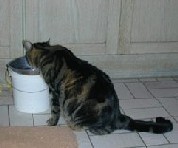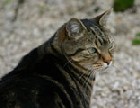| Tous
droits réservés, textes et photos © Harmonie Maître Animal 2001 |
Your Cats Behaviour Towards
Food |
Author Françoise GAUDRON (F) Animal Comportmentaliste
Translation by Suzanne LEVEL Chatterie de la Vieille Grange - Club AFAS (Siamois) Abysom n°58
and Céline GAUDRON
The wild ancestor of the cat, the giant African cat (Felis Sylvestris libyca), domesticated for nearly 5.000 years already fed on small prey: small rodents, insects, lizards and young birds. In Asian regions, the wildcat named viverrina cat or fishing cat (Felis viverrina) feeds on fish that it catches with its paws, using its claws as hooks.
The cat is a predator, a carnivore
that spends 25% of its time hunting and feeding. This skilful hunter seeks
its prey at dawn and at dusk. Solitary hunter, it does not accept any help
from its congener. Only the mother, she-cat in order to teach her offspring
the hunting techniques, will allow company. The hunting sequences follow one
after another:
Ø Initially the search for a prey
Ø Then the ambush or attack
Ø The chase
Ø The final kill, the column (neck)
Ø And finally the ripping up of the prey.
It's sharpened senses used for better hunting are: 
Ø Eye-sight which enables it to see the prey in half-light (highly reflective
retina) especially when they are moving
Ø Hearing, finer than that of the dog that is sensitive to the acute sounds
and ultrasounds........
Ø Taste and sense of smell developed from birth, which plays an important
part in the search for food. Taste and sense of smell are interdependent since
cats have a cavity in their palate named: Jakobson's organ or voméronasal
organ which enables them "to taste" the diffused odors in the air. The grimace
produced at this time is called " "flehmen reaction… ". …
And our current cat ?
It still feeds in the same manner, as did its ancestors, when it is free or
wild, as an opportunist, it eats what it finds. Our family cat has changed
its habits, due to the modern man who is always looking for the easy way to
find and feed with the ready made and well balanced: tins or pieces of meat
in jelly or various dried biscuits. That does not prevent it from hunting:
Warning, look out for your goldfish! But what happened to its personal tastes?
Studies showed that the she-cat could influence its kittens, by imitation,
between the 5/7th weeks for their food preferences. The food of the expecting
she-cat could also exploit the tastes of the kitten. If the breeder varies
what is given during the weaning period, the kitten will support any kind
of food, and will not be a difficult adult to feed.
| Cats are wary and selective when faced with new food. | |||
Fine gourmets, they like to change menus. Some support monotony a certain time, then are weary. They know how to communicate their preferences to their master. A cat would be able to refuse any food, even endanger its life, if it does not like a food. Each cat has its own food preferences; it is up to you to detect them. It is thus necessary to vary its food but be very careful, chocolate (coco) and onions are poisons for its organism. It is not advisable to radically change a cat's food as this can cause intestinal problems: in order to accustom it to new food, introduce a small quantity into its usual food then gradually increase. The best is to present various kinds of food to him at of the beginning. It is also not advisable to change from humid food to dried food as this can cause intestines problems.
Our cat is very delicate.
He detests eating close to his litter tray. Easy to understand! It has a preference
for crockery made out of glass or porcelain, always spotless and He May not
stand some washing up products.
|
|
||
In general, the cat privileges
morsels of food which are around 38°c (that of its preys) or at ambient temperature.
It seems to work with a food distributor. If the Master is present, he can
give him small "doses" at each passage. But be very careful to respect the
daily allowance because certain compulsive eaters sterilized she-cats or castrated
tomcats will not be able to stop.
The cat very close to its Master likes to imitate them: thus certain cats
sit down at table with their Master, take their food with their paws up to
their mouth, whilst others lie down along side their bowl and eat with their
paws.
The cat also has moderate consumption of water. As with its' food, it likes to drink frequently. It laps up small quantities here and there. There again, it shows its preference for certain water, not too hot and not too cold or chlorinated… It is important that there is always a fresh bowl of water, especially if it eats dried foods. The cat with a fresh bowl of water close to their food bowl, bit prefers to drink from the tap. Who knows why ? ...or the water of the dog ! |
 |
Cats adore eating certain plants, amongst other things catnip or cat
grass. If the cat lives in a flat, it will be charmed that you put a pot of
cat grass on your balcony or in a corner of the flat. However, sometimes the
cat prefers your houseplants, and it is necessary to be vigilant because the
dieffenbachia, philodendron, amaryllis, lily of the valley, yucca, ficus,
hyacinth, tulip, daffodil, Narcissi, fern, rhododendron, begonia, rose, laurel
and many others are toxic. They adore rubbing against the mint planted in
the garden and to crunch the leaves. Our small felines adore certain plants
like the valerian, the olive-tree, and thyme…
For example, our cat "Baby" was fond of scratching and eating
mint's leaves that our daugther had planted in our garden.
It is known that psychologically, the relation with food depends on our attitude (case of anorexia's), our environment and our health. We know well that to tame an animal it is enough to use food to decrease its distance from escape and to bind it to us.
The way in which the cat nourishes itself is thus a "barometer" for the
Master.
When it refuses its food more than 2 to 3 days, various questions should be
raised:
Ø Does my cat have the food that is appropriate to him?
Ø Is its sense of smell functioning?
Ø Is it sick?
Ø Could it have undergone some kind of stress at the time of the last food
ingestion?
Ø Could it have been stressed by a change in its environment?
Ø Arrival or absence of another cat, another human, removal, change in the
apartment?
Ø Family arguments
Ø Loud or unusual noises
Ø Is my relationship with my cat excessive?
Ø Was it weaning well done?
Ø Was I instrumental in his behavior of beggar by giving him the food, which
it begs?
Many abnormal behaviors can appear around food in peaks (a cat which devours all that presents even the objects not consumable), bulimia or anorexia, the Coprophagie (ingestion of droppings), the polydipsy (excessive consumption of water) or the kneader, wool or fabric eater.)
|
_______________________________________________________
Références
WOLTER en 1982 1984 Mac DONALD
et coll. 1980 MUGFORD et THORNE
Séminaire Société Francophone de Félinothechnie " Le comportement du chat
" ________________________________________________________________________________________________
 |
